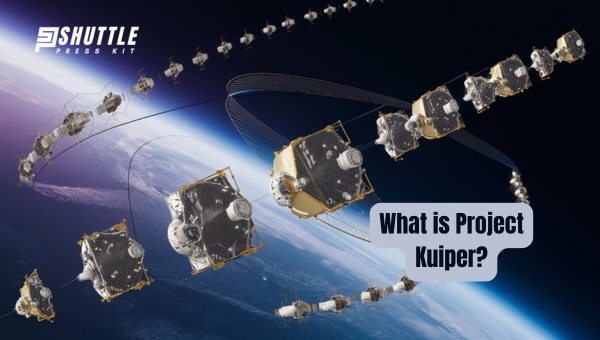Have you ever imagined a world where the internet reaches every corner of the globe? This is not just a dream anymore. Project Kuiper: Amazon’s Satellite Internet Provider is stepping in to make this possible.
Picture this: No matter where you are, the vastness of the Sahara or the cold stretches of Siberia, you’re connected. Intrigued? Let’s dig deeper into how Amazon plans to revolutionize our digital lives.
Project Kuiper aims to launch thousands of satellites into Earth’s lower orbit. Their mission is simple yet ambitious – to provide high-speed, affordable internet access across the globe.
This means better connectivity for remote and rural areas that have been left in the digital dark ages. With Project Kuiper, Amazon isn’t just launching satellites; they’re bridging gaps and connecting worlds.
What is Project Kuiper?
Project Kuiper is an ambitious initiative led by Amazon to deploy a constellation of low Earth orbit (LEO) satellites aimed at providing high-speed broadband internet access globally.

The project aims to bridge the digital divide by offering reliable internet services in underserved and remote areas where traditional broadband infrastructure is lacking or unavailable. Approved by the Federal Communications Commission (FCC) in 2020, Amazon plans to launch over 3,000 satellites into LEO.
The network will leverage advanced technology to deliver fast and stable internet connections, supporting various applications from telemedicine and education to entertainment and business operations.
Project Kuiper also highlights Amazon’s commitment to innovation, as it seeks synergies with its existing cloud computing services offered through AWS (Amazon Web Services). The endeavor not only represents a significant technological leap but also aims at fostering greater digital inclusivity worldwide.
Also Read: How Much Does Starlink Internet Costs? Pricing Revealed
Availability Timeline of Project Kuiper
Prototype Launch: The first two prototype satellites, KuiperSat-1 and KuiperSat-2, were successfully launched on October 6, 2023. These prototypes are crucial for testing the technology and capabilities of the satellite network.

Production Satellites: Amazon plans to have its first batch of production satellites ready for launch by the end of 2024. This marks a delay from earlier expectations of launching in the first half of 2024 due to various production challenges and the need for thorough testing.
Beta Testing: Initial beta services for Project Kuiper are now expected to begin in early 2025. This phase will initially be available to select commercial customers, with broader residential service anticipated to follow.
Regulatory Requirements: Under its FCC license, Amazon is required to launch at least 50% of its planned 3,236 satellites by July 30, 2026. This includes a commitment to have a significant portion of the constellation operational to meet the growing demand for broadband access.
Long-Term Goals: The complete deployment of the satellite constellation is projected to be achieved by 2029. This timeline allows Amazon to establish a robust network capable of delivering high-speed internet to underserved areas globally.
Objective Behind Project Kuiper
This ambitious initiative seeks to provide high-speed broadband internet access to underserved and remote areas worldwide.

By ensuring connectivity in regions where traditional internet services are unavailable or unreliable, Project Kuiper intends to enhance opportunities for education, healthcare, and economic development.
The project’s broader vision includes complementing Amazon’s portfolio while also competing with other satellite internet providers like SpaceX’s Starlink.
By leveraging advanced satellite technology and infrastructure, Project Kuiper strives to ensure that more people around the globe can participate in the digital economy and benefit from online resources.
Project Kuiper vs Starlink
| Feature | Project Kuiper | Starlink |
|---|---|---|
| First Announced | 2019 | 2015 |
| Parent Company | Amazon | SpaceX |
| Subscriber Count | None yet | Over 2 million |
| Satellites in Orbit | 2 prototype satellites launched | Over 5,000 satellites deployed |
| Proposed Constellation Size | 3,276 satellites | 42,000 satellites approved, plans for up to 30,000 |
| Pricing | Not disclosed yet | $90-$110/month for residential plan in US, plus $599 equipment fee |
| Availability | Not available yet, targeting late 2024 | Available in over 60 countries since November 2020 |
| Orbit Altitude | 370-390 miles | Around 340 miles |
| Launch Agreements | 80 launches secured with Arianespace, Blue Origin, SpaceX, ULA | Ongoing launches with SpaceX |
| Customer Terminals | Compact, affordable designs planned | Residential, business, RV, maritime, and aviation options |
| Sustainability | Designed to minimize orbital debris risk | Working with astronomers to reduce satellite visibility |
Also Read: Starlink’s Rivals and Competitors: Who’s Challenging SpaceX?
FAQs
What is Project Kuiper?
It’s an initiative by Amazon to provide high-speed internet through a constellation of satellites in low Earth orbit, aimed at improving global internet access.
How does Project Kuiper work?
The project plans to deploy satellites that will create a network to deliver internet connectivity directly to user terminals on the ground, enabling global coverage.
Who can benefit from Project Kuiper?
It targets a wide audience, especially those in remote and underserved communities where traditional internet infrastructure is limited or nonexistent.
How will Project Kuiper differ from existing satellite internet services?
It promises to offer faster speeds, lower latency, and more affordable access compared to current satellite internet options, making it competitive in the global market.
Also Read: How Much Does Starlink Internet Costs? Pricing Revealed
Conclusion
Project Kuiper signifies a monumental leap in bridging the global digital divide, promising high-speed internet connectivity across the most remote corners of the planet. Spearheaded by Amazon, this ambitious satellite internet initiative stands to revolutionize access to the digital world, fostering unprecedented opportunities for education, business, and communication.
By deploying a constellation of satellites in low Earth orbit, Project Kuiper aims not just to enhance online accessibility but also to ensure that the internet’s reach is as boundless as humanity’s potential. As we stand on the cusp of this new era of connectivity, the promise of Project Kuiper shines a beacon of hope for a more inclusive, connected world.
![Project Kuiper [Amazon's Leap into Satellite Internet]](https://shuttlepresskit.com/wp-content/uploads/2024/09/Project-Kuiper-Amazons-Leap-into-Satellite-Internet-450x340.jpg)